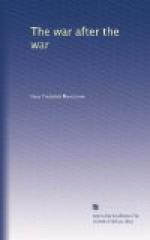Of course England and France could have met the situation by shipping gold. Each had a large reserve but the United States had all the gold it wanted, and still has. Besides, in such an emergency gold is an inert and unproductive commodity.
Again, the Allies might have “dumped” their American securities representing an investment of over three billions of dollars, which would have upset the American stock market and sent prices down. Either one of these performances would have done us no good.
It was important, therefore, for the benefit of all interest involved, that the Allies establish a credit in the United States that would enable them to buy freely and remove the costly handicap on American exchange. In a word, instead of having to pay their bills through an intricate mechanism that rose and fell with the tides of trade and put a premium on trading with us, a medium was needed that would restore the whole economic trade balance. It was as essential to us as to our customers.
Hence the Anglo-French Five Hundred Million Dollar Loan was floated and Uncle Sam became a war banker. This loan, however, was nothing more or less than the setting up of a credit of half a billion dollars for England and France in the United States. To put it in another way, it is just as if the two Allies had deposited this sum in an American bank and then drew checks against it for goods and raw materials made or mined in America. In a word, we lent to ourselves.
Put out at a time when money was scarce, the loan would have been unpatriotic and uneconomic. But our banks were filled with idle cash: everywhere capital sought safe and profitable employment. Now you begin to see why these allied loans are really good business in more ways than one.
What is our financial stake in the cost of the war: what does it yield: how is it safeguarded?
Clearly to understand this whole situation you must know just how these foreign bonds are put out. There are two kinds. One is the internal loan issued in the money of the country whose name it bears. This means that if it is a French bond it is in terms of francs: if English it calls for payment in pounds sterling: if Russian, in roubles: if German, in marks. An external loan, on the other hand, is issued in the money of the country in which it is floated. The Anglo-French loan is an example of this kind because both principal and interest are to be paid in United States gold coin. These internal and external loans may be direct obligations of the issuing governments or may be secured by collateral.
There is still a third medium for the employment of American money in the war. Technically it is known as bank credit. Through this agency, foreign firms make deposits of money or collateral in the national banks of their respective countries and purchase goods in America through credits thus established for them in a group of New York banks or trust companies. The acceptances for the goods thus bought become negotiable documents and are bought and sold by institutions and investors at a discount.




